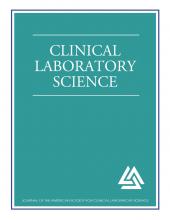This article requires a subscription to view the full text. If you have a subscription you may use the login form below to view the article. Access to this article can also be purchased.
- ↵* Corresponding author; email: fydrysna{at}shp.rutgers.edu
Abstract
Introduction: The medical laboratory professional workforce shortage in the United States has been documented through several national survey reports that also describe the use of temporary staffing to fill vacancies. The primary study objectives were to determine the extent of the workforce shortage in Montana and describe the usage of temporary staffing to fill vacancies. Study Objectives: The study objectives were: 1) Identify Montana CLIA laboratories by geographical area classification, 2) Identify usage of temporary medical laboratory professionals based on laboratory type, 3) Determine wage differences between full time/part time permanent employees versus temporary medical laboratory professionals, 4) Determine the usage rates of temporary medical laboratory professionals, 5) Identify the cause(s) for usage of temporary staffing, and 6) Determine the length of time to fill vacancies. Method: An electronic survey comprised of multiple choice, dichotomous, short answer and open-ended questions was developed to collect qualitative and quantitative data and was distributed via email. Results: The survey was sent to 83 facilities, with a 54% (n=45) response rate. Of respondents, 49% (n=22) reported employing temporary staffing, and 51% (n=23) do not employ temporary staffing. The reasons for hiring temporary staffing included: unable to fill the position (62%), medical leave (13%), vacation (10%), and other reasons such as deployment, maternity leave, short-staffed, administrative projects (15%). Of the 22 facilities employing temporary staffing, 45% (n=10) have a temporary staffing budget line item. Conclusion: The survey results indicated there is a medical laboratory professional shortage in Montana, and compared to the national rate, the usage of temporary staffing is higher, and vacancies take longer to fill by up to two years. The usage of temporary staffing is more than twice as high compared to national survey rates. The state specific data obtained from this study provided vital information to the Montana clinical laboratory community and could serve as an impetus to work collaboratively to explore solutions to the shortage based on state specific needs. The survey design can also serve as an example for other states to conduct similar studies to gather state specific information versus national survey aggregate data.
- Received November 9, 2018.
- Accepted November 14, 2018.
- Published by American Society for Clinical Laboratory Science







